

Queueing Theory IE 502: Probabilistic Models Jayendran Venkateswaran IE & OR
Example: Which is better? • Suppose at Bank X, the customers arrivals are a Poisson process with rate λ . All incoming customers join a single queue and are served in FIFO order. Now, the customers can be served by either of two clerks available. Service times of each clerk is exponentially distributed with rate μ • Suppose at Bank Y also, the customers arrivals are a Poisson process with rate λ . All incoming customers join a single queue and are served in FIFO order. Now, the customers are served by a single clerk whose service times are exponentially distributed with rate 2 μ. • In which of the above system will the expected time spent in system be smaller? IE502: Probabilistic Models IEOR @ IITBombay
Example: Which is better? ( in other words ) • System X is a M/M/2 system with arrivals at rate λ and service at each server at rate μ . Now, consider System Y which is a M/M/1 system having arrival rate λ and service rate 2 μ . • Compare W , the expected time customer spends in systems X and Y . Specifically, – Is W X > W Y ? – Is W X < W Y ? – Is W X = W Y ? • Is the result intuitive? Does similar result hold for waiting time in the queues? IE502: Probabilistic Models IEOR @ IITBombay
M/M/1/K λ μ K • Storage capacity of system is K (one customer in service and K − 1 customers in the waiting line) and the exceeding customers are refused. • State space representation of M/M/1/K queue • What is the limiting probabilities P n for M/M/1/K? • Compute expected number in system, L. • Compute expected time a customer spends in system, W . IE502: Probabilistic Models IEOR @ IITBombay
Example • Customers arrive at a bar at the rate of λ per hour. The bar provides service at the rate of μ. It costs the bar Rs. cμ per hour to offer service at that rate. Suppose that the bar gets a revenue of Rs. A for every customer served. If the bar has a capacity of K seats, what service rate μ maximizes the total profit? IE502: Probabilistic Models IEOR @ IITBombay
Recommend
More recommend